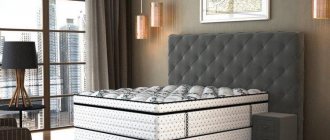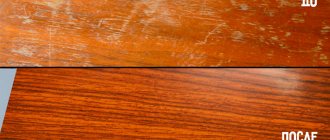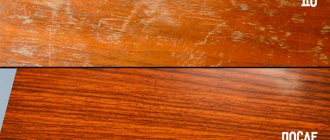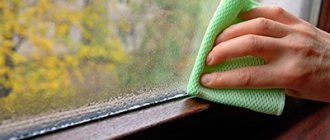The damage from high humidity in the house is not always noticeable immediately or with the naked eye, but it exists. Dampness is a favorable environment for the growth and development of many bacteria, parasites, and molds. In addition, a heavy, unpleasant odor often spreads in a damp room. For this reason, you should know how to get rid of dampness in your apartment in order to make life safe and comfortable. Both industrial and folk remedies will help.
What causes high humidity in the house?
Dampness in the house is manifested by condensation on window glass and mirrors, dampness of things, a musty smell, wet spots on the wallpaper and under the ceiling. If nothing is done, mold will grow in the room.
Dampness and mold fungi in the house threaten:
- decreased immunity;
- destruction of supporting structures;
- chronic colds;
- failure of electrical appliances;
- allergies;
- the appearance of stains on furniture and wallpaper;
- asthma, etc.
High humidity
Drawing conclusions
Let's summarize:
We have found out how to remove dampness in a room, and the first step must be to find the source of this problem. Having an idea of methods to combat high humidity, you can correct the situation yourself. External problems should begin to be solved by insulating the building itself; do not forget to insulate the external walls and seal the seams between the panels
Then follows the process of thermal insulation of the apartment itself. First of all, we check the ventilation power and clean it. We ventilate all rooms in the house, bathrooms and kitchen as often as possible. It is advisable to install an air conditioner, because it will be very useful in such a situation. When preparing food in the kitchen, do not forget to turn on the hood. Indoor plants also need to be chosen carefully - it is better if they are varieties that do not need frequent watering. When purchasing a dehumidifier, pay attention to its capacity.
Causes of high humidity in the house
You can deal with dampness in your home only by determining the cause of its occurrence. Natural reasons lead to an increase in humidity (washing, wet cleaning, cooking, steam formation in the bathroom, etc.). When breathing, one person releases up to 4 liters of liquid per day. These factors do not always lead to dampness; most often the reasons for high humidity are other.
Helpful advice. To find the source of dampness, you need to fix the glass against the wall overnight. It must be pressed tightly against the plane of the wall. If no condensation has formed on the glass by morning, the cause is dampness inside the room.
Humidity in the house increases due to:
- hanging wet laundry indoors;
- lack of a ventilation system or disturbances in its operation;
- plastering and finishing works;
- insufficient waterproofing of the foundation;
- increasing groundwater levels;
- lack of external insulation of the foundation;
- leakage of construction pits;
- defective drainage;
- uneven distribution of heat in the house;
- freezing walls;
- indoor plants;
- leaking roof, defects in roof overhang;
- walls lined with furniture;
- damage to water or sewer pipes;
- irregular or excessive ventilation;
- improper operation of the heating system;
- improper installation of double-glazed windows, their defects, high tightness;
- problems with thermal and waterproofing of walls;
- proximity to the sump;
- swimming pool located on the ground floor;
- damaged or clogged drain;
- aquariums.
Prevention
So that residents do not have to worry about how to remove dampness from the walls, it is important to know effective ways to prevent its occurrence. It is enough to take a number of simple measures:
- Ventilate the room for at least 10-15 minutes every day, creating a draft;
- Dry clothes only on the balcony or outside;
- Equip a ventilation system in the kitchen;
- Use air filters - models equipped with a Nera filter are more preferable;
- Install air conditioners in combination with fungicidal filters against mold fungi;
- Do not overuse wet cleaning.
It is not so easy to completely remove fungus from dampness on the walls. It often reappears from spores that survived treatment deep in the floor structure.
Ensuring your own health and safety of your home is not so difficult. To do this, it is enough to follow the basic rules for caring for the premises. And when mold appears, under no circumstances should the problem be left to chance.
How to reduce humidity levels in your home
To eliminate dampness, special equipment, preparations and folk remedies are used. Thanks to them, it is possible to significantly reduce humidity, but these are temporary measures. To completely get rid of dampness and prevent its reappearance, it is necessary to eliminate the causes.
How to determine humidity
You can dry the air using:
- Chemical preparations (Cerizite stop moisture, Stop Dampness, Drypet skit, Torrbollen, etc.). They act on the principle of a sorbent. Sold in hardware stores and online stores. They are mainly produced on the basis of calcium chloride.
- Air dryers. Air conditioners with dehumidification function.
- Heating devices (warm floor system, heaters, etc.).
- Home remedies (salt, rice, etc.). They are placed in the corners of the room.
There are four types of dehumidifiers:
- compressor units (can dry large rooms, but take up a lot of space and are noisy);
- with thermoelectric converters (they are quieter, but the power is much lower);
- adsorption (the stronger the sorbent absorbs moisture, the lower its efficiency becomes);
- rotary (combine the functions of adsorption and compressor equipment).
Note! Don't get too carried away with the fight against dampness. Low levels of air humidity are also harmful. Its optimal indicator is 45%. Humidity below 30% and above 60% is a violation. You can measure accurate data using a hygrometer.
Humidity measurement device
Humidity due to poor ventilation
Very often, the cause of dampness is poor performance of the ventilation system or its complete absence. After eliminating this problem, the humidity level can be significantly reduced.
Ventilation cannot work properly due to:
- obstruction;
- poor sealing;
- improperly equipped exit above the roof;
- insufficient cross-sectional area of the ventilation duct.
To restore normal ventilation, you need to invite a specialist. He will inspect the system and determine the cause of the problem.
A clogged system must be cleaned:
- remove the grille;
- wash it with detergent;
- remove dirt from the walls using a scraper;
- vacuum the channel;
- wash it with a damp cloth (as far as your hand can reach);
- put the ventilation grille in place.
The ventilation shaft is clogged.
At high humidity, you can use a forced ventilation system: reversible, exhaust or supply. It is installed in the ventilation duct. When there is no ventilation in the house at all, you need to make a through hole in the wall and install a recuperator in it. It must be covered with bars from the inside and outside.
Might be interesting
Waterproofing
How to choose the right floor waterproofing for screed?
Waterproofing
Foundation waterproofing: optimal choice of technology
Waterproofing
Clean water is the key to health, waterproofing concrete…
Waterproofing
Instructions for waterproofing a swimming pool
Another reason for dampness is improper installation of double-glazed windows. If mold appears on the window slopes, you need to level them and foam the cracks again. To prevent condensation from settling on the glass, do not clutter the window sills. This prevents the normal circulation of warm air. Window sills that are too large lead to the same consequences. To fix this, you need to drill holes in them.
Important! Fans, hoods and air conditioners need to be cleaned regularly. Otherwise, the device itself will become a source of bacteria and mold.
Windows that are too sealed are also a cause of increased humidity. How to lower the humidity level in this case? The problem of dampness can be solved using a window pressure ventilator, a hydraulically controlled ventilation valve or a vent fan. You can simply remove the rubber seal on top of the window frame. There is no need to do this with all double-glazed windows at once: first treat one window, then (if that doesn’t help) the next one, and continue until the result is obtained.
The source of moisture is under the floor
If there is no ventilation in the underground, it is necessary to equip it. Waterproofing walls and floors, sealing gaps and cracks help to significantly reduce the level of humidity at home. For this, waterproofing plaster is used.
Dampness in the cellar may appear due to leaky construction pits. To eliminate the problem, you need to seal it with waterproof clay (clay castle).
Foundation drainage device
Changes in groundwater levels lead to dampness in the house. To solve this problem, you need to properly organize the drainage system.
Another reason is poor foundation waterproofing.
In this case, vertical waterproofing is necessary:
- coating waterproofing;
- penetrating compounds;
- vertical lining of the foundation with waterproofing.
Note! The service life of waterproofing materials is not infinite. In an old house, it may be out of order.
How to get rid of the effects of fungus?
When you have taken all measures to eliminate the cause of the fungus, you can move on to the next stage - removing mold and drying the wall, after which you can begin repairs. First, all old coatings are manually removed from the walls, and then the wall is thoroughly dried with soffits, a hair dryer, or electric heaters. The best option for such a procedure would be infrared heaters, the radiation of which penetrates deep into the surface and dries it as efficiently as possible. If the case is “severe”, then it is necessary to remove the layer of plaster, and drill holes in the places where the fungus is most widespread to see the depth of the damage. And do not forget that all the described procedures must be carried out in a respirator so that dust and fungal spores do not enter the body.
The cause of dampness is the roof and walls
Conventional heating methods help warm the air in the home. They are not able to warm up the walls. Condensation forms on cold surfaces. Because of this, the humidity in the room increases.
You can correct the situation using:
- heating convector;
- infrared heater;
- increasing the footage of the heating system;
- arrangement of heated floors;
- thermal and waterproofing of walls.
Note! Do not apply finishing materials with high acidity to affected surfaces. Mold spores thrive in such an environment. It is better to give preference to compounds with a neutral or alkaline reaction.
When dampness “sets in”, wet stains appear on the wallpaper, mold spots appear on the ceiling and under it. This is caused by holes in the roof and damaged gutters. Waterproofing the ceiling will not help here. The water will soak into the walls and still seep into the house.
The work must be done from the attic side. To eliminate the causes, it must be examined. Then, if necessary, carry out waterproofing and restoration work. It is necessary to carefully treat the cracks, cracks and joints. Clogged gutters can be cleared out using a garden hose.
Folk remedies for dampness in the apartment
Folk recipes also help to dry the air in the apartment:
- With the onset of summer, in warm weather, it is recommended to treat walls that are not wallpapered and covered with mold with the following composition: dissolve half a kilogram of laundry soap in five liters of water, then boil the mixture. Cover the wall evenly with a cooled soap solution using a brush and let dry. Repeat the treatment several times. Traces of soap suds should form on the wall. After this, apply another composition consisting of 100 grams of alum diluted in six liters of water.
- Calcium chloride absorbs moisture excellently. Place containers with this substance in damp areas of the room. The advantage of calcium chloride is its reusability. It is enough to dry it (for example, in an oven). Be sure to crush calcium chloride before use.
- Treatment with a mixture of salicylic acid and alcohol will help eliminate mold and prevent the spread of dampness. Dry the walls thoroughly. After this, combine one part salicylic acid and two hundred (200) parts alcohol. Dilute the mixture with a small amount of clean water. Lubricate the black mold spots with the resulting product.
Advice! Replace calcium chloride with charcoal or quicklime.
What to do if the cause is dampness indoors
Installing a heated towel rail in the bathroom
When high humidity in the house is not associated with poor ventilation or violation of construction technologies, it is much easier to deal with it. You just need to follow certain recommendations.
To prevent the humidity level in the house from increasing, you need to:
- during the daytime (especially in summer) keep the curtains open;
- do not put undried laundry in the closet;
- check the integrity of water and sewer pipes and eliminate defects;
- reduce the humidity level in the kitchen using a hood;
- perform 5-minute through ventilation 3 times a day;
- during cooking, reduce the heat so that the container can be tightly closed with a lid;
- if it is impossible to dry clothes outside the house, let things drain over the bathtub, then hang them closer to the hood;
- keep interior doors open in the house;
- on the doors of wet rooms, install ventilation holes at the bottom (from 200 sq. cm);
- do not place furniture close to the walls;
- When wet cleaning the house, wring out the rag well;
- do not keep filled buckets and bathtubs for a long time;
- reduce the number of flowers in the house, reduce the frequency and volume of watering.
Helpful advice! Installing a heated towel rail will help reduce the humidity level in the bathroom. It can be electric, water, combined.
How to deal with the companion of dampness - mold
How to deal with mold
The lesion is formed due to high humidity. To prevent its occurrence, you need to understand why dampness appeared in the house. Only by eliminating the cause can you completely get rid of mold.
They fight lesions in the house using various compounds:
- mildew removers:
- antiseptic primer;
- 3% hydrogen peroxide solution;
- soda solution (1 tsp per 200 ml of water);
- alcohol;
- urea solution (temperature 50 degrees);
- 10% bleach solution, etc.
Important! Hydrogen peroxide and bleach can lighten the surface. They must be used with caution. You can use the products on painted surfaces, but only after checking the durability of the coloring pigments (in a small area).
The surface must be prepared before treatment. The wall needs to be cleaned of wallpaper and plaster. Then dry it thoroughly using a heater. After this, you can begin surface treatment. Anti-mold agents must be applied to the affected surface. Then dry the wall thoroughly.
Dampness and mold in the house are dangerous to health. They lead to the destruction of building structures and damage to property. Humidity in a home can increase due to various factors. If the problem is caused by human activities, dehumidifiers can help. In other cases, it is necessary to find out the causes of high humidity in the house and eliminate them. Otherwise the problem will return again and again.
What plaster should be used to plaster walls to avoid mold?
To prevent such problems, special plasters with additives are used, called sanitizing or drying plasters. They are based on a cement-lime mixture, since lime together with cement provides the mixture with softness and lightness. Additives in the composition are necessary to provide it with the porosity necessary for salt accumulation and constant movement of steam.
It is worth mentioning one more factor. In this case, we are not talking about wall insulation, although the fact that after plastering the walls the temperature in the room will rise by a couple of degrees is very pleasant.











